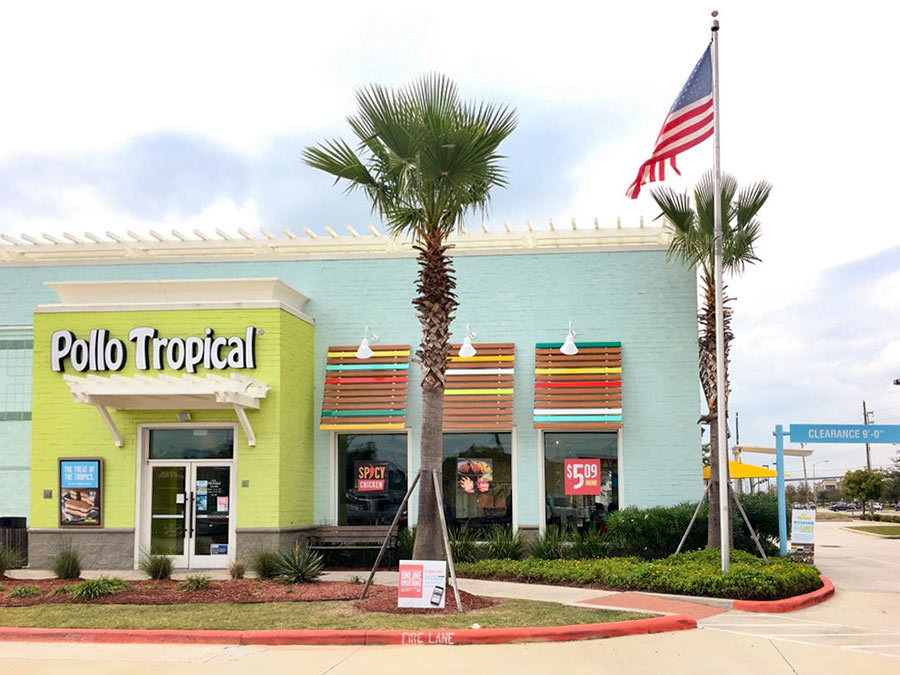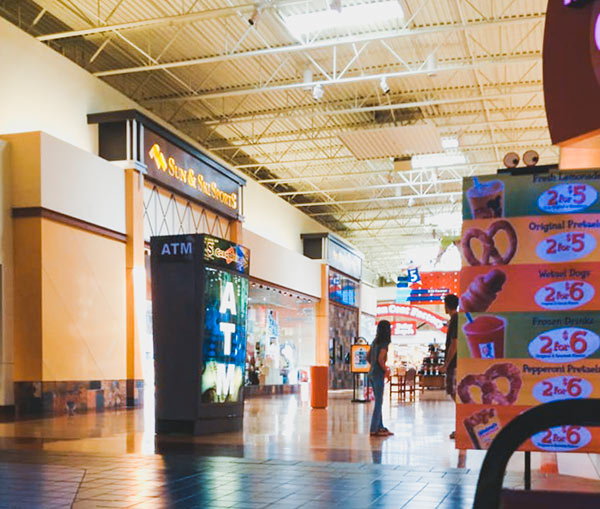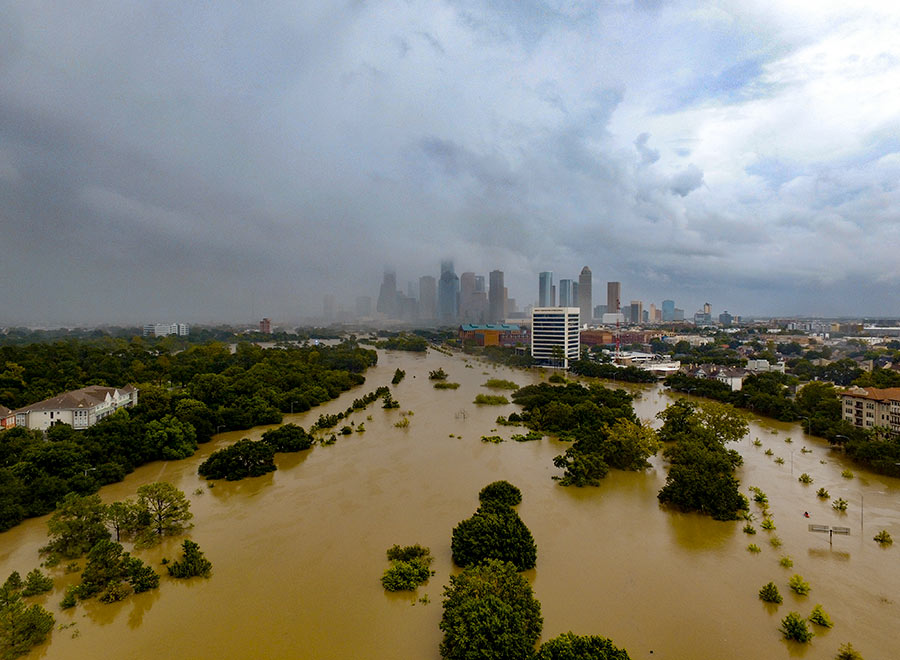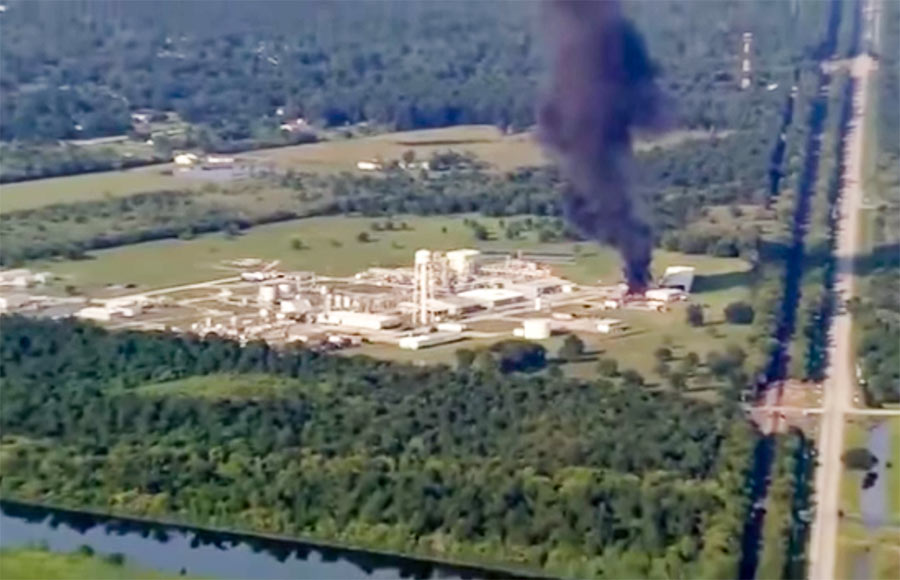POLLO TROPICAL SUNSET  Citing “limited awareness” of the brand, the corporate parent of Pollo Tropical has decided not to reopen the last 2 remaining Houston-area locations of the Caribbean chicken fast-food chain after they were both damaged by floodwaters from Hurricane Harvey. Gone for good: the Pollo Tropical on Westheimer Rd. just west of Eldridge and the other at 11400 Broadway just east of Kirby Dr. in Pearland (pictured here). Three other Houston-area Pollo Tropicals closed in April. Fiesta Restaurant Group, which also owns the Taco Cabana chain, said in a release that it was also closing all 4 locations in San Antonio but might reopen as many as 2 of the shuttered restaurants in the region as Taco Cabanas. [BusinessWire; Houston Press] Photo: Fernando C.
Citing “limited awareness” of the brand, the corporate parent of Pollo Tropical has decided not to reopen the last 2 remaining Houston-area locations of the Caribbean chicken fast-food chain after they were both damaged by floodwaters from Hurricane Harvey. Gone for good: the Pollo Tropical on Westheimer Rd. just west of Eldridge and the other at 11400 Broadway just east of Kirby Dr. in Pearland (pictured here). Three other Houston-area Pollo Tropicals closed in April. Fiesta Restaurant Group, which also owns the Taco Cabana chain, said in a release that it was also closing all 4 locations in San Antonio but might reopen as many as 2 of the shuttered restaurants in the region as Taco Cabanas. [BusinessWire; Houston Press] Photo: Fernando C.
Quicklink
COMMENT OF THE DAY: WAKE ME UP WHEN HOUSTON’S WAKE-UP CALLS ARE OVER  “The idea that the Houston area has just been complacent all this time and needs to ‘wake up’ is ridiculous. Houston has been steadily improving its situation for decades through various means (infrastructure, regulation, mitigation, response, etc.). This progression got particular boosts by these larger events and we will see the same needed boost post-Harvey. But realize these rainfall events over the last 2+ years have been off the charts and applying these lessons learned takes years.” [Rex, commenting on Comment of the Day: The Even Bigger Reason Houston Might Want To Address Its Flooding Problems] Illustration: Lulu
“The idea that the Houston area has just been complacent all this time and needs to ‘wake up’ is ridiculous. Houston has been steadily improving its situation for decades through various means (infrastructure, regulation, mitigation, response, etc.). This progression got particular boosts by these larger events and we will see the same needed boost post-Harvey. But realize these rainfall events over the last 2+ years have been off the charts and applying these lessons learned takes years.” [Rex, commenting on Comment of the Day: The Even Bigger Reason Houston Might Want To Address Its Flooding Problems] Illustration: Lulu
WEST HOUSTON CAN NOW FLUSH IN GOOD CONSCIENCE  When last we (and the aircraft supplying aerial images to NOAA) left the West District wastewater treatment plant along Buffalo Bayou just outside Beltway 8 at the flooded southeast corner of Memorial Glen, it looked like this: shut down and surrounded by muddy floodwaters sorely in need of its services. That was September 3rd. As of this morning, the city’s Office of Emergency Management reports, both this plant and the one on Turkey Creek off Eldridge between Briar Forest Dr. and Memorial have been restored to full operation. This means persons in ZIP Codes 77024, 77041, 77043, 77055, 77077, 77079, 77080 and 77094 who had been following guidelines to limit their water use are once more free to shower, flush, brush, and otherwise send wastewater down their drains without special consideration of the consequences. [Alert Houston; previously on Swamplot] Aerial image of West District plant from September 3: NOAA
When last we (and the aircraft supplying aerial images to NOAA) left the West District wastewater treatment plant along Buffalo Bayou just outside Beltway 8 at the flooded southeast corner of Memorial Glen, it looked like this: shut down and surrounded by muddy floodwaters sorely in need of its services. That was September 3rd. As of this morning, the city’s Office of Emergency Management reports, both this plant and the one on Turkey Creek off Eldridge between Briar Forest Dr. and Memorial have been restored to full operation. This means persons in ZIP Codes 77024, 77041, 77043, 77055, 77077, 77079, 77080 and 77094 who had been following guidelines to limit their water use are once more free to shower, flush, brush, and otherwise send wastewater down their drains without special consideration of the consequences. [Alert Houston; previously on Swamplot] Aerial image of West District plant from September 3: NOAA
COMMENT OF THE DAY: THE EVEN BIGGER REASON HOUSTON MIGHT WANT TO ADDRESS ITS FLOODING PROBLEMS  “People in Houston need to talk with people in other parts of the country to be able to understand the need for funding massive improvements in our flood control infrastructure. I had friends and family from LA to Philly telling me to get out of the city and come stay with them as soon as it was possible to travel out of the city. My sister even offered to drive her minivan over 1,200 miles to come rescue me. I still have family asking me whether they should cancel plans to visit over Thanksgiving for fear that hotels will be full and no rental cars are available.
It is easy to get all worked up about taxes when you did not get flooded and go into the usual red state “don’t tax me, tax that guy behind the tree†mode. But much more is at stake for Houston than whether parts of the city keep flooding. We run the risk of being seen as a city that is not worth the risk for existing and prospective businesses. People in Houston are getting used to these flood events and are not pressed into action by aerial footage on CNN showing Buffalo Bayou turning into a raging torrent. But everywhere else in the US, people see that and are completely freaked out by it. If we continue with applying band aids and do not make any big dramatic moves to improve our flood control infrastructure, we will not only be risking future catastrophic flooding but will also be risking losing current and future business to cities that are on higher ground away from the path of hurricanes and tropical storms.” [Old School, commenting on Comment of the Day: Abandoned Neighborhoods Make Great Detention Ponds] Illustration: Lulu
“People in Houston need to talk with people in other parts of the country to be able to understand the need for funding massive improvements in our flood control infrastructure. I had friends and family from LA to Philly telling me to get out of the city and come stay with them as soon as it was possible to travel out of the city. My sister even offered to drive her minivan over 1,200 miles to come rescue me. I still have family asking me whether they should cancel plans to visit over Thanksgiving for fear that hotels will be full and no rental cars are available.
It is easy to get all worked up about taxes when you did not get flooded and go into the usual red state “don’t tax me, tax that guy behind the tree†mode. But much more is at stake for Houston than whether parts of the city keep flooding. We run the risk of being seen as a city that is not worth the risk for existing and prospective businesses. People in Houston are getting used to these flood events and are not pressed into action by aerial footage on CNN showing Buffalo Bayou turning into a raging torrent. But everywhere else in the US, people see that and are completely freaked out by it. If we continue with applying band aids and do not make any big dramatic moves to improve our flood control infrastructure, we will not only be risking future catastrophic flooding but will also be risking losing current and future business to cities that are on higher ground away from the path of hurricanes and tropical storms.” [Old School, commenting on Comment of the Day: Abandoned Neighborhoods Make Great Detention Ponds] Illustration: Lulu
COMMENT OF THE DAY RUNNER-UP: FEAR OF A RAISED FOUNDATION  “What I’ve found to be true, anecdotally at least, is that most people who have never lived in a house with a pier and beam foundation have ZERO interest in them. They are disoriented, confused by, and even scared of them. Some of them are a little creeped out by the thought of having empty space under their floorboards. (What’s that noise? Will I have to go down there at some point?!?!?) Despite some of the most beautiful and pricey homes being built in this way, some of these people still see it as antiquated and, even, a sign of shoddy construction not designed to last.” [driftwood, commenting on How About We Don’t Sell People Homes in Areas That Keep Flooding, and Other Crazy Ideas for Houstonians To Discuss Amongst Themselves] Illustration: Lulu
“What I’ve found to be true, anecdotally at least, is that most people who have never lived in a house with a pier and beam foundation have ZERO interest in them. They are disoriented, confused by, and even scared of them. Some of them are a little creeped out by the thought of having empty space under their floorboards. (What’s that noise? Will I have to go down there at some point?!?!?) Despite some of the most beautiful and pricey homes being built in this way, some of these people still see it as antiquated and, even, a sign of shoddy construction not designed to last.” [driftwood, commenting on How About We Don’t Sell People Homes in Areas That Keep Flooding, and Other Crazy Ideas for Houstonians To Discuss Amongst Themselves] Illustration: Lulu
COMMENT OF THE DAY: RENTING AFTER HARVEY  “What if a rental tenant brings to the attention of a landlord that the sheetrock and flooring need to be replaced in order for the home to be habitable. Then, the landlord agrees and ends the lease, deems the costs associated with repair to be uneconomical and tears down the house. The family living there has no place to go as every rental property in the same price strata has been leased. What then? This is not a rhetorical question. I have TWO close friends with young children in this situation. Landlord wants to tear down the homes because repairs too costly. Both families have money to pay rent, but can’t find a home to rent. Advice is welcome.” [Nice Neighbor, commenting on A Flood of Eviction Notices; Meyerland, Before and After; Here Come the Mosquitoes] Illustration: Lulu
“What if a rental tenant brings to the attention of a landlord that the sheetrock and flooring need to be replaced in order for the home to be habitable. Then, the landlord agrees and ends the lease, deems the costs associated with repair to be uneconomical and tears down the house. The family living there has no place to go as every rental property in the same price strata has been leased. What then? This is not a rhetorical question. I have TWO close friends with young children in this situation. Landlord wants to tear down the homes because repairs too costly. Both families have money to pay rent, but can’t find a home to rent. Advice is welcome.” [Nice Neighbor, commenting on A Flood of Eviction Notices; Meyerland, Before and After; Here Come the Mosquitoes] Illustration: Lulu
COMMENT OF THE DAY RUNNER-UP: ABANDONED NEIGHBORHOODS MAKE GREAT DETENTION PONDS  “I grew up off Fairbanks/West Little York area. TS Allison was the third time Creekside Estates and Woodland Trails West II had flooded which meant those homes wouldn’t be insured for future floods. Both of those neighborhoods are almost completely gone now, mainly just streets people use to cut through. Even with all the new construction/neighborhoods built near Breen Rd, nothing around has flooded since. The south side of WTW where Gulf Bank runs through flooded twice in late ’90s, along with Philippine St. in Jersey Village. Neither of those areas have had a third flood event; not Ike, Memorial Day flood, Tax Day flood or Harvey could flood them. A huge reason why has got to be because old Creekside Estates and WTW II hold so much of the water that would’ve flooded them out that costly third time years ago. Sometimes you have to cut loose some fat for the overall good and I know it sounds heartless but I’ve seen it work. These very flood prone neighborhoods just have to be made into retention areas because it works.” [mas, commenting on How About We Don’t Sell People Homes in Areas That Keep Flooding, and Other Crazy Ideas for Houstonians To Discuss Amongst Themselves] Illustration: Lulu
“I grew up off Fairbanks/West Little York area. TS Allison was the third time Creekside Estates and Woodland Trails West II had flooded which meant those homes wouldn’t be insured for future floods. Both of those neighborhoods are almost completely gone now, mainly just streets people use to cut through. Even with all the new construction/neighborhoods built near Breen Rd, nothing around has flooded since. The south side of WTW where Gulf Bank runs through flooded twice in late ’90s, along with Philippine St. in Jersey Village. Neither of those areas have had a third flood event; not Ike, Memorial Day flood, Tax Day flood or Harvey could flood them. A huge reason why has got to be because old Creekside Estates and WTW II hold so much of the water that would’ve flooded them out that costly third time years ago. Sometimes you have to cut loose some fat for the overall good and I know it sounds heartless but I’ve seen it work. These very flood prone neighborhoods just have to be made into retention areas because it works.” [mas, commenting on How About We Don’t Sell People Homes in Areas That Keep Flooding, and Other Crazy Ideas for Houstonians To Discuss Amongst Themselves] Illustration: Lulu
COMMENT OF THE DAY SECOND RUNNER-UP: THE CANAL PLAN FOR HOUSTON  “Build canals everywhere. Become the American Amsterdam. Rather than a Pierce Elevated park . . . have a canal that can take on additional water from Buffalo Bayou. Canals throughout Montrose, Midtown, Downtown and around Washington. Canals on the East End and through EaDo. Canals near the Med Center to relieve Brays Bayou, and on and on and on again. Give water new dedicated places to go that we can call amenities, and make Houston a more interesting and attractive place to recruit new companies and tourists, because our canals are unique and cool places to hang out. The Dutch know water, so why not copy them.
Then release a ton of GMO mosquitos to kill off the rest of them.” [Canalguy, commenting on How About We Don’t Sell People Homes in Areas That Keep Flooding, and Other Crazy Ideas for Houstonians To Discuss Amongst Themselves] Illustration: Lulu
“Build canals everywhere. Become the American Amsterdam. Rather than a Pierce Elevated park . . . have a canal that can take on additional water from Buffalo Bayou. Canals throughout Montrose, Midtown, Downtown and around Washington. Canals on the East End and through EaDo. Canals near the Med Center to relieve Brays Bayou, and on and on and on again. Give water new dedicated places to go that we can call amenities, and make Houston a more interesting and attractive place to recruit new companies and tourists, because our canals are unique and cool places to hang out. The Dutch know water, so why not copy them.
Then release a ton of GMO mosquitos to kill off the rest of them.” [Canalguy, commenting on How About We Don’t Sell People Homes in Areas That Keep Flooding, and Other Crazy Ideas for Houstonians To Discuss Amongst Themselves] Illustration: Lulu
COMMENT OF THE DAY: FLOATING HOMES FOR HOUSTON  “I’m a ship designer with 20+ years of experience and I will say that a float-off house is absolutely feasible from a technical point of view. A quick check in the used barge market shows that you can get something house-sized (80 ft. by 30 ft.) for $65,000. Of course building something on-site would cost a lot more than construction in a shipyard. Not sure how this compares to what a foundation costs. But you’d need to add in some kind of anchoring system so that your house doesn’t float away when it floods. And permitting would be a whole other kettle of fish. I’m available for moonlighting if any architect wants to investigate this for a client!” [Orang Bodoh, commenting on Where Are Houston’s Floodwater-Ready Homes]
“I’m a ship designer with 20+ years of experience and I will say that a float-off house is absolutely feasible from a technical point of view. A quick check in the used barge market shows that you can get something house-sized (80 ft. by 30 ft.) for $65,000. Of course building something on-site would cost a lot more than construction in a shipyard. Not sure how this compares to what a foundation costs. But you’d need to add in some kind of anchoring system so that your house doesn’t float away when it floods. And permitting would be a whole other kettle of fish. I’m available for moonlighting if any architect wants to investigate this for a client!” [Orang Bodoh, commenting on Where Are Houston’s Floodwater-Ready Homes]
WHY YOU MIGHT WANT TO THINK TWICE BEFORE EVEN APPLYING FOR AN SBA LOAN AFTER HARVEY  As lines begin to form at the 3 new disaster recovery centers opened today at the Katy Mills Mall, Greenspoint Mall, and Baytown Community Center, people seeking assistance from FEMA or the Small Business Administration after their homes or businesses were damaged by the storm may want to know about a little HUD rule passed in 2011. Intended to prevent victims from receiving assistance for the same disaster from 2 separate agencies (which had cost the government $1 billion after Hurricane Katrina and the Midwest floods a few years later), the rule ended up going a little further than that: “Every dollar for which disaster victims are approved for an SBA loan is a dollar less they can receive from a federal grant,” reports Danny Vinik in Politico. “In other words, if a victim who is eligible for $120,000 in assistance is offered a $90,000 SBA loan, she can only receive grants worth $30,000—no matter if she accepts or declines the loan.” Complicating the issue for some: low-interest-rate SBA Disaster Loans can provide funds within a few weeks; any outright grants from FEMA would take much longer. [Houston Chronicle; Politico] Photo of ATM at Katy Mills Mall: Cindy D.
As lines begin to form at the 3 new disaster recovery centers opened today at the Katy Mills Mall, Greenspoint Mall, and Baytown Community Center, people seeking assistance from FEMA or the Small Business Administration after their homes or businesses were damaged by the storm may want to know about a little HUD rule passed in 2011. Intended to prevent victims from receiving assistance for the same disaster from 2 separate agencies (which had cost the government $1 billion after Hurricane Katrina and the Midwest floods a few years later), the rule ended up going a little further than that: “Every dollar for which disaster victims are approved for an SBA loan is a dollar less they can receive from a federal grant,” reports Danny Vinik in Politico. “In other words, if a victim who is eligible for $120,000 in assistance is offered a $90,000 SBA loan, she can only receive grants worth $30,000—no matter if she accepts or declines the loan.” Complicating the issue for some: low-interest-rate SBA Disaster Loans can provide funds within a few weeks; any outright grants from FEMA would take much longer. [Houston Chronicle; Politico] Photo of ATM at Katy Mills Mall: Cindy D.
WHAT THE HARVEY FLOODING DID TO BUFFALO BAYOU PARK  “Please know that Buffalo Bayou Park was designed to flood, although we did not anticipate three historic flooding events in 1-1/2 years,” Buffalo Bayou Partnership president Anne Olson remarks drily in an email update this afternoon. So what’s the damage? “The bottom two thirds of the park are still under water, and we expect that they will remain so for several more weeks as water is released from the Addicks and Barker reservoirs. Due to these circumstances, it is difficult for our staff to assess the impact the flowing water has had on the footpaths and landscape in these areas. We do know that the Johnny Steele Dog Park, which is still submerged, will be closed for two or three months.” Water and sediment that flooded the Buffalo Bayou Cistern is still draining, slowly, but the electrical system installed when the long-hidden underground space was made available for tours and art installations appears to be working. The Wortham Fountain and the trail lighting system have been damaged, Olson reports. The Bayou City Adventures kayak kiosk at Lost Lake
“Please know that Buffalo Bayou Park was designed to flood, although we did not anticipate three historic flooding events in 1-1/2 years,” Buffalo Bayou Partnership president Anne Olson remarks drily in an email update this afternoon. So what’s the damage? “The bottom two thirds of the park are still under water, and we expect that they will remain so for several more weeks as water is released from the Addicks and Barker reservoirs. Due to these circumstances, it is difficult for our staff to assess the impact the flowing water has had on the footpaths and landscape in these areas. We do know that the Johnny Steele Dog Park, which is still submerged, will be closed for two or three months.” Water and sediment that flooded the Buffalo Bayou Cistern is still draining, slowly, but the electrical system installed when the long-hidden underground space was made available for tours and art installations appears to be working. The Wortham Fountain and the trail lighting system have been damaged, Olson reports. The Bayou City Adventures kayak kiosk at Lost Lake and the Bike Barn at Sabine St. has been shut down for the remainder of the year at least; areas east of the Sabine St. bridge are mostly still underwater. But Olson reports landscaped areas in the upper areas of the park, where trails have already reopened, survived with only a small amount of damage: “We are extremely fortunate that the Lost Lake and Wortham Insurance Visitor Centers did not take on water. Both facilities are open and the Kitchen at The Dunlavy is operating with normal hours. Food trucks also are back in the entry court at Sabine Street from Thursday-Sunday.” Update: The Bike Barn at Sabine St. has resumed normal hours as of September 9. [Buffalo Bayou Partnership] Photo: Adam Brackman.
SOMETHING POWERFUL IN THE CROSBY AIR  This vivid description is included in the original petition of a lawsuit filed today against Arkema, operators of the chemical plant off the Beaumont Hwy. in Crosby — by 7 first responders injured after incidents there last week: “In the early morning hours of August 31, 2017, the first of several explosions occurred as a result of the abandoned chemicals heating up and igniting. Although the explosions had occurred, no one from Arkema alerted the first responders who were manning the perimeter of the arbitrary mandatory evacuation area. Immediately upon being exposed to the fumes from the explosion. and one by one. the police officers and first responders began to fall ill in the middle of the road. Calls for medics were made, but still no one from Arkema warned of the toxic fumes in the air. Emergency medical personnel arrived on scene. and even before exiting their vehicle, they became overcome by the fumes as well. The scene was nothing less than chaos. Police officers were doubled over vomiting, unable to breathe. Medical personnel, in their attempts to provide assistance to the officers became overwhelmed and they too began to vomit and gasp for air. Some of the police officers. unable to abandon their vehicles due to their weapons being present, jumped in their vehicles and drove themselves to the nearest hospital. The other officers and medical personnel were all placed in an ambulance, and were driven to the hospital.†[Houston Chronicle; International Business Times] Still image of smoke from fire after Thursday’s explosion: abc13
This vivid description is included in the original petition of a lawsuit filed today against Arkema, operators of the chemical plant off the Beaumont Hwy. in Crosby — by 7 first responders injured after incidents there last week: “In the early morning hours of August 31, 2017, the first of several explosions occurred as a result of the abandoned chemicals heating up and igniting. Although the explosions had occurred, no one from Arkema alerted the first responders who were manning the perimeter of the arbitrary mandatory evacuation area. Immediately upon being exposed to the fumes from the explosion. and one by one. the police officers and first responders began to fall ill in the middle of the road. Calls for medics were made, but still no one from Arkema warned of the toxic fumes in the air. Emergency medical personnel arrived on scene. and even before exiting their vehicle, they became overcome by the fumes as well. The scene was nothing less than chaos. Police officers were doubled over vomiting, unable to breathe. Medical personnel, in their attempts to provide assistance to the officers became overwhelmed and they too began to vomit and gasp for air. Some of the police officers. unable to abandon their vehicles due to their weapons being present, jumped in their vehicles and drove themselves to the nearest hospital. The other officers and medical personnel were all placed in an ambulance, and were driven to the hospital.†[Houston Chronicle; International Business Times] Still image of smoke from fire after Thursday’s explosion: abc13
WHERE ARE HOUSTON’S FLOODWATER-READY HOMES?  A reader asks: “Is there not a single architect in Houston who has envisioned a flood resistant home? Polished concrete floors with large area rugs instead of wood or wall-to-wall carpet? Waterproof material (instead of drywall) three or four feet up from the slab; removable of course so you can remove the wet insulation after the next flood? How much more do cabinets cost if they are made from marine grade plywood? Surely there’s a business case for a house that you can basically hose off and re-decorate after a flood, right?” Illustration: Popular Mechanics
A reader asks: “Is there not a single architect in Houston who has envisioned a flood resistant home? Polished concrete floors with large area rugs instead of wood or wall-to-wall carpet? Waterproof material (instead of drywall) three or four feet up from the slab; removable of course so you can remove the wet insulation after the next flood? How much more do cabinets cost if they are made from marine grade plywood? Surely there’s a business case for a house that you can basically hose off and re-decorate after a flood, right?” Illustration: Popular Mechanics
COMMENT OF THE DAY: COULD WE BORROW BRAYS BAYOU RIGHT AFTER YOUR NEXT FLOOD, PLEASE?  “. . . An undergound aqueduct probably won’t resolve the situation. However, this storm has made it pretty clear that having both Barker AND Addicks draining 100 percent into Buffalo Bayou may not be ideal. An addition channel that would allow USACE to divert some of the Barker outflow to Brays Bayou would allow for some flexibility.
While Brays DID flood during Harvey, the water receded very quickly, with the water back within its banks and falling quickly while Buffalo Bayou was still rising.” [Angostura, commenting on Clearing Out the Mold; Houston’s Drinking Water Close Call; The Floodeds and the Flooded-Nots] Photo of construction at Addicks and Barker Dams: U.S. Army Corps of Engineers [license]
“. . . An undergound aqueduct probably won’t resolve the situation. However, this storm has made it pretty clear that having both Barker AND Addicks draining 100 percent into Buffalo Bayou may not be ideal. An addition channel that would allow USACE to divert some of the Barker outflow to Brays Bayou would allow for some flexibility.
While Brays DID flood during Harvey, the water receded very quickly, with the water back within its banks and falling quickly while Buffalo Bayou was still rising.” [Angostura, commenting on Clearing Out the Mold; Houston’s Drinking Water Close Call; The Floodeds and the Flooded-Nots] Photo of construction at Addicks and Barker Dams: U.S. Army Corps of Engineers [license]
HOUSTON’S NEW HIGH-WATER MARK  It took a journey to the moon for Houston to become Space City, an NBA championship for it to become Clutch City, thousands of years of storm drainage for it to become the Bayou City, its emergence as a lower-cost alternative to New York, LA, and Chicago to become Discount City, an American League pennant run for it to become Crush City, a clever marketing campaign that plays on the city’s famous sprawl and lack of zoning laws for it to become The City with No Limits, and a Hollywood movie for Houston to become the preferred invocation preceding any declaration that “We’ve Got a Problem.” Now, amid the fluid aftermath of Harvey and the resulting flood of worldwide media coverage for the city’s latest historic high-water event, is Houston set to become known as . . . That City That Floods? “This ‘Houston Hang In There’ logo designed by Chad Ehlinger has become the go-to symbol uniting the city of Houston during this trying time,” reads a note posted last week to the Facebook page of Cactus Music, promoting the sale of T-shirts emblazoned with the mark, with proceeds promised to JJ Watt’s Houston Flood Relief Fund. (Hats with a similar charitable promise are available now too.) Like all great logos, Ehlinger’s badge of hope accommodates alternate readings: Is that a hand raising high the city’s initial in a defiant gesture of pride? Or someone hanging on for dear life as the floodwaters rise? If so, do we imagine the next step: a one-handed pull-up, lifting ourselves out of our predicament and into a drier future? What would it take for a new civic identity to emerge from the floodwaters — one that incorporates a more honest recognition of the city’s fundamental ongoing battle with drainage? A message of perseverance provides great cover. [Cactus Music] Logo: Chad Ehlingerm
It took a journey to the moon for Houston to become Space City, an NBA championship for it to become Clutch City, thousands of years of storm drainage for it to become the Bayou City, its emergence as a lower-cost alternative to New York, LA, and Chicago to become Discount City, an American League pennant run for it to become Crush City, a clever marketing campaign that plays on the city’s famous sprawl and lack of zoning laws for it to become The City with No Limits, and a Hollywood movie for Houston to become the preferred invocation preceding any declaration that “We’ve Got a Problem.” Now, amid the fluid aftermath of Harvey and the resulting flood of worldwide media coverage for the city’s latest historic high-water event, is Houston set to become known as . . . That City That Floods? “This ‘Houston Hang In There’ logo designed by Chad Ehlinger has become the go-to symbol uniting the city of Houston during this trying time,” reads a note posted last week to the Facebook page of Cactus Music, promoting the sale of T-shirts emblazoned with the mark, with proceeds promised to JJ Watt’s Houston Flood Relief Fund. (Hats with a similar charitable promise are available now too.) Like all great logos, Ehlinger’s badge of hope accommodates alternate readings: Is that a hand raising high the city’s initial in a defiant gesture of pride? Or someone hanging on for dear life as the floodwaters rise? If so, do we imagine the next step: a one-handed pull-up, lifting ourselves out of our predicament and into a drier future? What would it take for a new civic identity to emerge from the floodwaters — one that incorporates a more honest recognition of the city’s fundamental ongoing battle with drainage? A message of perseverance provides great cover. [Cactus Music] Logo: Chad Ehlingerm

